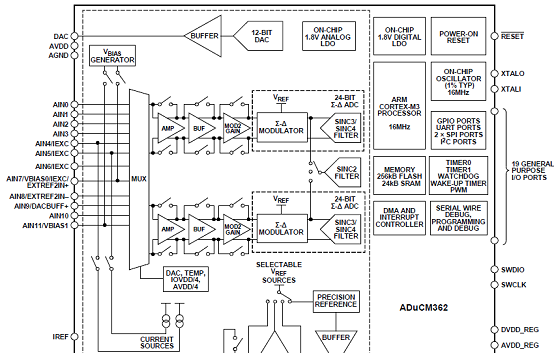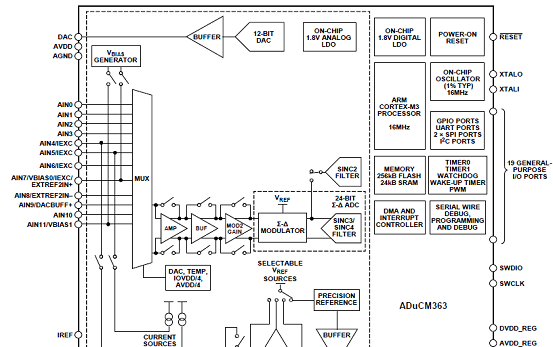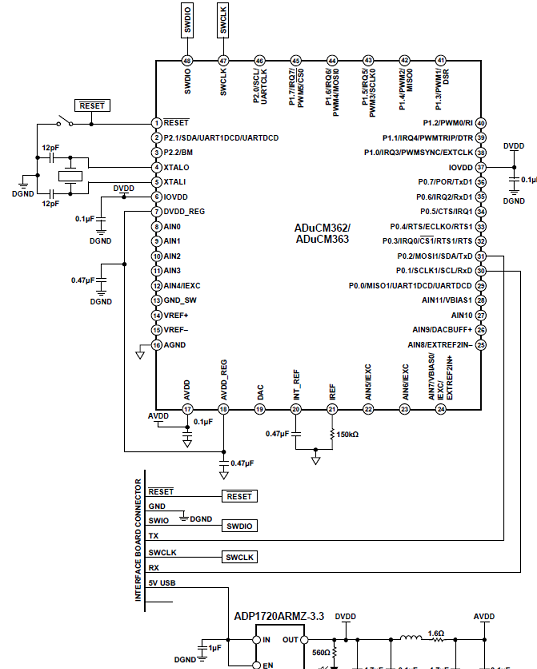基于ADI公司的ADuCM36324位数据采集系统解决方案
 200
200
 拍明
拍明
原标题:ADI ADuCM36324位数据采集系统解决方案
ADI公司的ADuCM362/3是集成单通道Σ-Δ型ADC和ARM Cortex-M3的低功耗精密模拟微控制器,在单芯片上集成了双核高性能多通道Σ-Δ型模数转换器(ADC),32位ARM Cortex™-M3处理器和Flash/EE存储器,是完全集成的3.9 kSPS,24位数据采集系统.主要应用在工业自动化和过程控制,智能精密传感系统,4-20mA 回路智能传感器系统以及医疗设备,病人监护.本文介绍了ADuCM362/3主要特性,ADuCM362和ADuCM363功能框图,典型系统配置图以及评估板EVAL-ADuCM360QSPZ主要特性,电路图和PCB设计图.
The ADuCM362/ADuCM363 are fully integrated, 3.9 kSPS, 24-bit data acquisition systems that incorporate dual, high performance, multichannel sigma-delta (Σ-Δ) analog-to-digital converters (ADCs), a 32-bit ARM Cortex™-M3 processor, and Flash/EE memory on a single chip. The ADuCM362/ ADuCM363 are designed for direct interfacing to external precision sensors in both wired and battery-powered applications. The ADuCM363 contains all the features of the ADuCM362, except that only one 24-bit Σ-Δ ADC (ADC1) is available. The ADuCM362/ADuCM363 contain an on-chip 32 kHz oscillator and an internal 16 MHz high frequency oscillator. The high frequency oscillator is routed through a programmable clock divider from which the operating frequency of the processor core clock is generated. The maximum core clock speed is 16 MHz; this speed is not limited by operating voltage or temperature. The microcontroller core is a low power ARM Cortex-M3 processor, a 32-bit RISC machine that offers up to 20 MIPS peak performance. The Cortex-M3 processor incorporates a flexible, 11-channel DMA controller that supports all wired communica- tion peripherals (both SPIs, both UARTs, and I2C). Also integrated on chip are up to 256 kB of nonvolatile Flash/EE memory and 24 kB of SRAM. The analog subsystem consists of dual ADCs, each connected to a flexible input mux. Both ADCs can operate in fully differential and single-ended modes. Other on-chip ADC features include dual programmable excitation current sources, diagnostic current sources, and a bias voltage generator of AVDD_REG/2 (900 mV) to set the common-mode voltage of an input channel. A low-side internal ground switch is provided to allow power-down of an external circuit (for example, a bridge circuit) between conversions. Optional input buffers are provided for the analog inputs and the external reference inputs. These buffers can be enabled for all PGA gain settings. The ADCs contain two parallel filters: a sinc3 or sinc4 filter in parallel with a sinc2 filter. The sinc3 or sinc4 filter is used for precision measurements. The sinc2 filter is used for fast measure- ments and for the detection of step changes in the input signal.
The devices contain a low noise, low drift internal band gap reference, but they can be configured to accept one or two external reference sources in ratiometric measurement config- urations. An option to buffer the external reference inputs is provided on chip. A single-channel buffered voltage output DAC is also provided on chip. The ADuCM362/ADuCM363 integrate a range of on-chip peripherals, which can be configured under microcontroller software control as required in the application. The peripherals include two UARTs, I2C, and dual SPI serial I/O communication controllers; a 19-pin GPIO port; two general-purpose timers; a wake-up timer; and a system watchdog timer. A 16-bit PWM controller with six output channels is also provided. The ADuCM362/ADuCM363 arespecifically designed to operate in battery-powered applications where low power operation is critical. The microcontroller core can be configured in a normal operating mode that consumes 290 μA/MHz (including flash/ SRAM IDD). An overall system current consumption of 1 mA can be achieved with both ADCs on (input buffers off), PGA gain of 4, one SPI port on, and all timers on. The ADuCM362/ADuCM363 can be configured in a number of low power operating modes under direct program control, including a hibernate mode (internal wake-up timer active) that consumes only 4 μA. In hibernate mode, peripherals, such as external interrupts or the internal wake-up timer, can wake up the devices. This mode allows the devices to operate with ultralow power while still responding to asynchronous external or periodic events. On-chip factory firmware supports in-circuit serial download via a serial wire interface (2-pin JTAG system) and UART; non- intrusive emulation is also supported via the serial wire interface. These features are incorporated into a low cost QuickStart™ Development System that supports this precision analog micro- controller family. The devices operate from an external 1.8 V to 3.6 V voltage supply and are specified over an industrial temperature range of −40°C to +125°C.
ADuCM362/3主要特性:
Pin compatible with the ADuCM360/ADuCM361
Analog input/output
Dual 24-bit ADCs (ADuCM362)
Single 24-bit ADC (ADuCM363)
Programmable ADC output rate (3.5 Hz to 3.906 kHz)
Simultaneous 50 Hz/60 Hz noise rejection
At 50 SPS continuous conversion mode
At 16.67 SPS single conversion mode
Flexible input mux for input channel selection to both ADCs
Two 24-bit multichannel ADCs (ADC0 and ADC1)
6 differential or 12 single-ended input channels
4 internal channels for monitoring DAC, temperature sensor, IOVDD/4, and AVDD/4 (ADC1 only) Programmable gain (1 to 128)
Gain of 1 with input buffer on/off supported
RMS noise: 52 nV at 3.53 Hz, 200 nV at 50 Hz
Programmable sensor excitation current sources
On-chip precision voltage reference
Two external reference options supported by both ADCs
Single 12-bit voltage output DAC
NPN mode for 4 mA to 20 mA loop applications
Microcontroller
ARM Cortex-M3 32-bit processor
Serial wire download and debug
Internal watch crystal for wake-up timer
16 MHz oscillator with 8-way programmable divider
Memory
Up to 256 kB Flash/EE memory, 24 kB SRAM
In-circuit debug/download via serial wire and UART
Power supply range: 1.8 V to 3.6 V (maximum)
Power consumption, MCU active mode
Core consumes 290 μA/MHz
Overall system current consumption of 1.0 mA with core operating at 500 kHz (both ADCs on, input buffers off, PGA gain of 4, one SPI port on, and all timers on)
Power consumption, power-down mode: 4 μA (wake-up timer active)
On-chip peripherals
2× UART, I2C, and 2 × SPI serial input/output (I/O)
16-bit pulse-width modulation (PWM) controller
19-pin multifunction GPIO port
2 general-purpose timers
Wake-up timer/watchdog timer
Multichannel DMA and interrupt controller
DMA support for both SPI channels
Package and temperature range
48-lead, 7 mm × 7 mm LFCSP
Specified for −40°C to +125°C operation
Development tools
Low cost QuickStart Development System
Third-party compiler and emulator tool support
Multiple diagnostic functions that support SIL certification
ADuCM363应用:
Industrial automation and process control
Intelligent precision sensing systems
4 mA to 20 mA loop-powered smart sensor systems
Medical devices, patient monitoring

图1.ADuCM362功能框图

图2.ADuCM363功能框图

图3.ADuCM362/3典型系统配置图
评估板EVAL-ADuCM360QSPZ
The ADuCM36x Multi-Functional Tool supports the ADuCM360/ ADuCM361 and ADuCM362/ADuCM363 products, and is composed of four parts: a graphical configuration utility for the analog front end (AFE) blocks, C code generator, sinc filter simulator, and a noise performance analysis feature.
The ADuCM36x Multi-Functional Tool gives customers the ability to quickly and easily evaluate and interact with complex AFE circuits. It allows customers to validate system level AFE performance both on the EVAL-ADuCM360QSPZ evaluation board or a custom evaluation board with automatically generated code.
评估板EVAL-ADuCM360QSPZ主要特性:
Graphically configure AFE blocks
Easy understanding of AFE blocks
Simple configuration of analog block registers with drop-down menus
Clear display of analog block register values and ADC configuration status
Avoid incorrect configuration through guiding dialog boxes
Saving and loading register values
C code generation for analog blocks based on user configuration
Compatible with the low level library functions provided by Analog Devices, Inc.
Noise analysis
Use on the EVAL-ADuCM360QSPZ evaluation board or a custom evaluation board
Analyze system level noise with the AFE blocks configuration
Use with any available ADC update rate
Select either ADC0 or ADC1 and any input channels
Sinc filter simulation
Multiple typical configurations are preconfigured for customers
Filter parameters and options are easily understandable

图4.评估板EVAL-ADuCM360QSPZ外形图
责任编辑:HanFeng
【免责声明】
1、本文内容、数据、图表等来源于网络引用或其他公开资料,版权归属原作者、原发表出处。若版权所有方对本文的引用持有异议,请联系拍明芯城(marketing@iczoom.com),本方将及时处理。
2、本文的引用仅供读者交流学习使用,不涉及商业目的。
3、本文内容仅代表作者观点,拍明芯城不对内容的准确性、可靠性或完整性提供明示或暗示的保证。读者阅读本文后做出的决定或行为,是基于自主意愿和独立判断做出的,请读者明确相关结果。
4、如需转载本方拥有版权的文章,请联系拍明芯城(marketing@iczoom.com)注明“转载原因”。未经允许私自转载拍明芯城将保留追究其法律责任的权利。
拍明芯城拥有对此声明的最终解释权。




 产品分类
产品分类















 2012- 2022 拍明芯城ICZOOM.com 版权所有 客服热线:400-693-8369 (9:00-18:00)
2012- 2022 拍明芯城ICZOOM.com 版权所有 客服热线:400-693-8369 (9:00-18:00)


